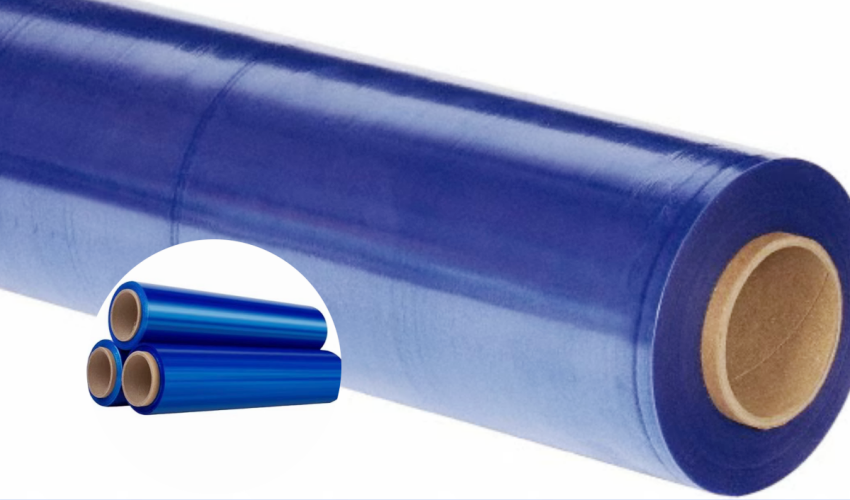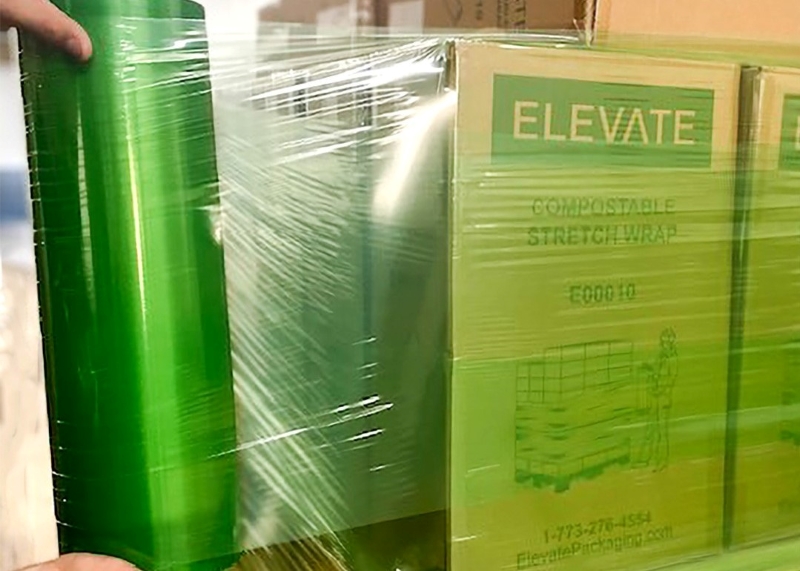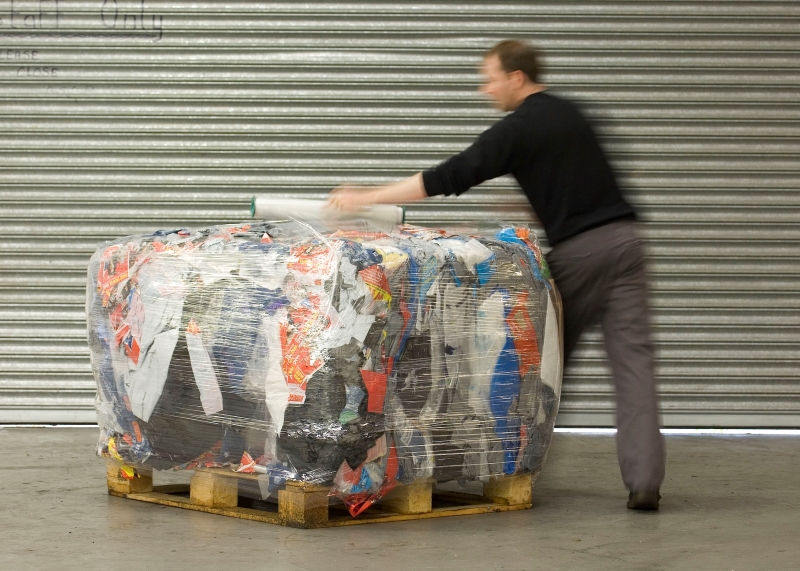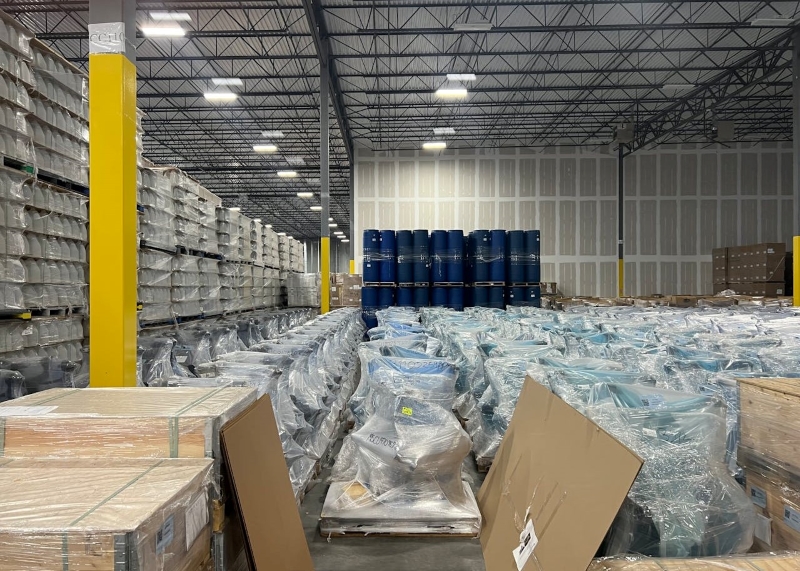
Plastic free pallet wrap refers to packaging solutions that do not rely on traditional plastic materials, offering an eco-friendly alternative for securing and stabilizing palletized goods. This type of wrap is typically made from renewable resources, such as paper or biodegradable materials, which can reduce environmental impact significantly. In some cases, breathable stretch film is also used, offering additional advantages by allowing air circulation around products. The importance of sustainable packaging solutions like plastic free pallet wrap lies in their ability to minimize waste and reliance on petroleum-based plastics. As businesses increasingly prioritize sustainability, adopting these alternatives can enhance brand reputation, appeal to environmentally conscious consumers, and contribute to overall waste reduction efforts in supply chains. Transitioning to such options is vital for a greener future. Plastic free pallet wrap is a cost-effective, sustainable, and recyclable alternative to plastic, including biodegradable stretch wrap, breathable mesh, and paper.
Reusable pallet wrap offers a variety of options that align with the principles of non plastic pallet wrap, providing sustainable solutions for securing and transporting goods. These options include wraps made from durable fabrics or specialized materials designed to withstand multiple uses.

Using reusable pallet wrap can lead to significant cost savings and reduced environmental impact. The benefits include:
Reusable pallet wrap can be utilized across diverse sectors, showcasing its versatility and effectiveness. Some practical applications include:
By integrating reusable pallet wrap into their operations, businesses can effectively support the principles of plastic free pallet wrap, promoting sustainability while achieving operational efficiency.
Biodegradable pallet wrap is an innovative solution designed to provide the protective qualities of traditional plastic wrap while aligning with the principles of plastic free pallet wrap. This type of wrap is made from natural materials that break down over time, making it a sustainable alternative for businesses looking to reduce their environmental footprint.
Biodegradable pallet wrap typically consists of materials such as:
The advantages of using biodegradable pallet wrap as packing pallets no plastic wrap include:
Incorporating biodegradable pallet wrap into packaging strategies not only supports the principles of plastic free pallet wrap but also fosters a more sustainable future for the environment.
Recycled stretch wrap serves as a sustainable option in the packaging industry, contributing to the goals of plastic free pallet wrap. Understanding how does stretch wrap work and its benefits can help businesses make informed decisions about their packaging materials.
Recycled stretch wrap is made from previously used plastic materials that have been processed to create new packaging solutions. This wrap retains many of the protective qualities of traditional stretch wrap while significantly reducing the amount of new plastic produced. The recycling process involves collecting used stretch wrap, cleaning it to remove contaminants, and then reprocessing it into new stretch film production.
Opting for recycled stretch wrap offers numerous advantages, including:
Recycling stretch wrap effectively requires awareness of proper procedures, which include:
Incorporating recycled stretch wrap into packaging strategies aligns with the principles of wrapping without pallet, promoting a more sustainable approach to packaging while supporting environmental initiatives.
Pallet film wrap is a crucial packaging solution used to secure and stabilize palletized goods during transportation and storage. It is essential to explore how pallet film wrap relates to plastic free pallet wrap, especially in the context of sustainability and environmental impact.

Pallet film wrap, also known as stretch film or stretch wrap, is a highly stretchable plastic film that clings tightly to items. Its primary function is to keep products securely bundled on pallets. Common applications include:
When evaluating pallet film wrap in the context of plastic free pallet wrap, several environmental considerations arise:
Understanding the role of pallet film wrap in relation to plastic free pallet wrap is crucial for businesses seeking sustainable packaging solutions. By considering the applications, comparisons, and environmental impacts, companies can make informed choices that align with their sustainability goals.
The evolution of machines designed for producing paper pallet wrap has revolutionized the packaging industry, particularly in the context of plastic free pallet wrap. These innovations have made it easier and more efficient for businesses to adopt sustainable packaging solutions.
Modern paper pallet wrap machines are equipped with advanced technology that enhances the production process. Key features of these machines include:
The shift towards paper pallet wrap presents numerous advantages for businesses, including:
Several companies have successfully integrated paper pallet wrap machines into their operations, showcasing the effectiveness of this transition. Notable examples include:
The innovations in paper pallet wrap machines significantly contribute to the movement towards plastic free pallet wrap, offering companies a viable and sustainable alternative that benefits both the environment and their bottom line.
As businesses strive to adopt more sustainable practices, exploring alternatives to traditional pallet wrap becomes essential. Many options provide effective solutions while aligning with the goals of plastic free pallet wrap.
Several alternatives to conventional pallet wrap have emerged, including:
Strapping
Reusable Pallet Wraps
Pallet Bands
Paper Pallet Wrap
Shrink Wrap
To effectively transition to more sustainable packaging practices, businesses should consider the following recommendations:
By exploring and implementing alternatives to traditional pallet wrap, businesses can significantly contribute to the goals of plastic free pallet wrap while promoting environmental sustainability and reducing their carbon footprint.
Non plastic shrink wrap presents an innovative alternative to traditional plastic wraps, particularly relevant in discussions around plastic free pallet wrap. This eco-friendly solution meets packaging needs while minimizing environmental impact.
Non plastic shrink wrap refers to packaging materials that shrink and conform to the shape of the product without utilizing conventional plastics. Common materials used in non plastic shrink wrap include:
The shift towards non plastic shrink wrap offers several sustainability benefits:
Non plastic shrink wrap represents a significant advancement in sustainable packaging solutions, aligning with the goals of plastic free pallet wrap. By embracing these alternatives, businesses can enhance their packaging efficiency while supporting environmental sustainability.
Recyclable plastic wrap plays a significant role in the pursuit of sustainability, particularly in the context of plastic free pallet wrap. While traditional plastics contribute to environmental issues, recyclable options provide an opportunity to reduce waste and support eco-friendly practices.
Recyclable plastic wrap is designed to be reused and recycled, offering similar protective qualities to conventional plastic wraps. Common uses of recyclable plastic wrap include:
To maximize the environmental benefits of recyclable plastic wrap, proper recycling practices are crucial. Consider the following factors:
As the demand for sustainable packaging solutions grows, several trends are emerging in the realm of recyclable materials:
Recyclable plastic wrap serves an important function in promoting sustainability and supporting the goals of plastic free pallet wrap. By focusing on proper recycling practices and staying attuned to future trends, businesses can contribute to a more sustainable packaging landscape while meeting consumer demands for environmentally responsible options.
In addition to avoiding plastic, plastic-free pallet wrap can be made from several sustainable materials, each with its own set of advantages and disadvantages. These alternatives aim to reduce the environmental impact of traditional plastic while still providing secure wrapping for pallets and bulk items. Let’s explore the most common materials used in plastic-free pallet wraps, how they compare to plastic, and the benefits they offer.
Materials Used:
Advantages:
Disadvantages:
Materials Used:
Advantages:
Disadvantages:
Materials Used:
Advantages:
Disadvantages:
Materials Used:
Advantages:
Disadvantages:
Materials Used:
Advantages:
Disadvantages:
Choosing the right material for plastic-free pallet wrap depends on the specific needs of your business and the type of goods you are transporting or storing. Biodegradable films and paper wraps offer sustainable alternatives but come with limitations in durability and moisture resistance. Mesh wraps are great for breathable packaging, while opaque vinyl and compostable films provide more robust options but can still face challenges with biodegradability and recycling. As the demand for sustainable solutions grows, new, more advanced materials like algae and mycelium-based wraps may offer the future of eco-friendly packaging. Ultimately, each material has its advantages and trade-offs, but all contribute to reducing reliance on harmful plastics.
When using plastic-free pallet wrap, it’s important to consider not just the wrap itself, but also the accessories and tools that help ensure efficient application and secure wrapping. These tools, like dispensers and stretchers, can have a significant impact on sustainability and environmental protection. As businesses and consumers continue to prioritize eco friendly pallet wrap, many manufacturers are developing tools and accessories that align with sustainable practices, reducing waste and minimizing environmental footprints.

Materials Used:
Sustainability Considerations:
Manual dispensers for plastic-free pallet wrap are essential for ease of use, especially in small-scale operations. Traditionally made of metal or plastic, these dispensers are now being developed with more sustainable materials. Recycled steel and wooden components are often used to create durable dispensers that reduce the need for new materials. Some dispensers are even made from biodegradable plastics or bamboo, which offer an eco-friendly alternative to traditional petroleum-based plastics.
Advantages:
Disadvantages:
Materials Used:
Sustainability Considerations:
Pallet wrap stretchers are used to apply tension to the film, ensuring it adheres tightly to the pallet. Traditionally, stretchers were made of metal and plastic, but as the demand for eco-friendly solutions grows, many manufacturers are now focusing on developing stretchers with recycled metals or biodegradable plastics. Wooden stretchers have also become a popular choice for their renewable nature, especially in lower-volume applications.
Advantages:
Disadvantages:
Materials Used:
Sustainability Considerations:
Roll holders help maintain the structure of the plastic-free pallet wrap and prevent tangling or damage during storage and handling. These holders are now often made from recycled cardboard or metal components. By using recycled materials in their construction, these holders help reduce waste and encourage circularity. Bamboo and wood are also popular alternatives for creating eco-friendly roll holders that are biodegradable and compostable.
Advantages:
Disadvantages:
Materials Used:
Sustainability Considerations:
Cutting tools used for plastic-free pallet wrap are essential for removing the wrap cleanly and safely. Many cutting tools are now manufactured with recycled metals or bioplastics, making them more environmentally friendly. In some cases, manufacturers have also focused on designing tools with replaceable blades, which extends their lifespan and reduces the need for frequent replacements.
Advantages:
Disadvantages:
Sustainability in the packaging industry extends beyond the materials used for plastic-free pallet wrap itself to include the accessories and tools that aid in its application. By adopting tools made from recycled metals, bamboo, and biodegradable plastics, businesses can reduce their environmental impact while maintaining packaging efficiency. The transition toward more eco-friendly tools and accessories not only supports sustainable packaging but also aligns with broader efforts to reduce the reliance on harmful plastics. Though these solutions may carry higher upfront costs, they offer long-term benefits in terms of durability, recyclability, and the overall environmental footprint, making them worthwhile investments for businesses committed to sustainability.
As the demand for plastic-free pallet wrap continues to grow, manufacturers are increasingly focusing on producing products that meet environmentally friendly and biodegradable standards. To ensure that plastic-free pallet wraps comply with sustainability goals and regulatory requirements, manufacturers must adhere to a range of industry standards and certifications. These standards not only validate the eco-friendliness of the products but also provide consumers with confidence in the environmental impact of their packaging choices.
ASTM D6400 is an internationally recognized standard for labeling plastics that are biodegradable in a commercial composting environment. This standard ensures that products like plastic-free pallet wrap are biodegradable, leaving no toxic residue behind.
Key Requirements:
Advantages:
Challenges:
EN 13432 is a European standard that certifies products as compostable. For plastic-free pallet wrap, this standard ensures that the material will break down in industrial composting facilities, leaving behind no harmful residues. It’s widely recognized across Europe and increasingly used globally.
Key Requirements:
Advantages:
Challenges:
OK Compost Home certification is for biodegradable products that can break down in a home composting environment. This is an essential certification for plastic-free pallet wrap manufacturers targeting consumers who compost at home rather than relying on industrial composting facilities.
Key Requirements:
Advantages:
Challenges:
The BPI certification is a prominent U.S.-based certification for compostable products. Products with BPI certification must meet the standards set by ASTM D6400 or EN 13432 and be tested in both industrial and home composting environments.
Key Requirements:
Advantages:
Challenges:
Cradle to Cradle is a certification program that evaluates the overall sustainability of products, considering factors like material health, product circularity, water stewardship, and social fairness. For plastic-free pallet wrap, achieving Cradle to Cradle certification demonstrates a commitment to creating products with minimal environmental impact throughout their lifecycle.
Key Requirements:
Advantages:
Challenges:
The Global Recycle Standard (GRS) ensures that recycled materials used in manufacturing are traceable and meet stringent environmental and social criteria. Manufacturers of plastic-free pallet wrap using recycled or upcycled materials can pursue GRS certification to prove that their products are made from responsibly sourced, recycled materials.
Key Requirements:
Advantages:
Challenges:
For plastic-free pallet wrap made from paper or wood-based materials, the FSC certification is a critical standard. It ensures that the raw materials used in manufacturing come from responsibly managed forests that adhere to environmental, social, and economic standards.
Key Requirements:
Advantages:
Challenges:
Adhering to the right industry standards and certifications is crucial for plastic-free pallet wrap manufacturers striving to meet biodegradable or environmentally friendly standards. Certifications like ASTM D6400, EN 13432, and Cradle to Cradle provide assurance that products meet sustainability benchmarks, helping manufacturers gain consumer trust and improve environmental outcomes. As demand for eco-friendly packaging continues to grow, aligning with these standards will be key to the success of plastic-free pallet wrap solutions in a competitive, eco-conscious market.
As sustainability becomes a top priority in the packaging industry, plastic-free pallet wrap is rapidly evolving to meet the growing demand for environmentally friendly and degradable packaging solutions. With increasing concerns about plastic pollution and the harmful impact of non-biodegradable materials on the environment, manufacturers are focusing on innovative technologies and materials that reduce the environmental footprint of pallet wrapping. In this section, we will explore the key trends and technologies driving the future of plastic-free pallet wrap, highlighting the role of biodegradability, material innovation, and circular economy principles.
One of the most significant trends in the development of plastic-free pallet wrap is the shift toward biodegradable and compostable materials. As traditional plastic wraps take hundreds of years to decompose, the need for alternative materials that break down naturally and quickly is critical for reducing landfill waste.
Future Developments:
Advantages:
Challenges:
Another significant trend is the use of recycled and upcycled materials in the production of plastic-free pallet wrap. As the circular economy gains momentum, manufacturers are looking to reduce the reliance on virgin materials by incorporating recycled resources into the production process.
Future Developments:
Advantages:
Challenges:
In the pursuit of plastic-free solutions, natural fibers and plant-based materials are becoming an increasingly popular choice for plastic-free pallet wrap. Materials such as hemp, jute, cotton, and flax are being explored as potential alternatives to traditional plastic wraps.
Future Developments:
Advantages:
Challenges:
As manufacturers focus on plastic-free pallet wrap, the future will see more functional wraps that can still perform at high levels without relying on plastic.
Future Developments:
Advantages:
Challenges:
The integration of smart packaging technologies in plastic-free pallet wrap is an exciting trend that could revolutionize the way products are stored, transported, and tracked.
Future Developments:
Advantages:
Challenges:
The future of plastic-free pallet wrap is exciting and full of potential. With advancements in biodegradable materials, natural fibers, recycled resources, and smart packaging, the industry is moving toward sustainable, high-performance alternatives to traditional plastic wraps. While challenges such as durability, cost, and scalability remain, ongoing research and innovation are helping to bridge the gap. As demand for sustainable packaging continues to rise, plastic-free pallet wraps will play a key role in reducing plastic waste and promoting a more environmentally responsible packaging industry.
When considering alternatives to traditional pallet wrapping, several options can effectively secure and protect goods during storage and transportation while promoting sustainability. One popular alternative is strapping, which involves using durable bands to hold loads together. Strapping is especially effective for uniform loads and can be adjusted to fit various sizes, but it may require careful application to ensure safety.
Reusable pallet wraps made from materials like fabric or flexible polymers offer another option. These wraps can be used multiple times, significantly reducing waste and providing a secure fit for various products. Additionally, pallet bands are elastic bands designed to hold loads together, allowing for easy application and adjustment, although they may not be as effective for smaller quantities.
Paper pallet wraps have gained popularity as a biodegradable option that can provide similar protective qualities as plastic wraps. Finally, biodegradable shrink wraps are emerging as an eco-friendly option that shrinks tightly around products and decomposes naturally, offering a sustainable choice for businesses looking to minimize their environmental impact.
Cling wrap and pallet wrap serve different purposes, although both are used in packaging. Cling wrap, often made from polyethylene, is primarily designed for wrapping food items or smaller products to keep them fresh. It adheres to surfaces through static cling, making it suitable for household use or small-scale applications. Cling wrap is thin and flexible, allowing it to mold closely to the contours of the item it covers, which is ideal for items like fruits, vegetables, and leftovers.
In contrast, pallet wrap, or stretch film, is specifically engineered for wrapping larger items, such as pallets of products, for transport and storage. Pallet wrap is thicker and more robust than cling wrap, providing enhanced protection against damage during shipping. It is designed to stretch tightly around items, ensuring that they remain securely bundled together, even under the stresses of movement and handling. Additionally, pallet wrap is typically used in commercial settings, making it an essential component in logistics and supply chain management, while cling wrap is more commonly found in domestic kitchens.
Environmentally friendly plastic wrap refers to packaging materials designed to serve the same purpose as traditional plastic wrap but with less environmental impact. These alternatives are made from biodegradable, recyclable, or compostable materials. One example is plastic-free pallet wrap, which can be made from plant-based materials like corn starch, or other biodegradable resins. These wraps are often designed to be used in a similar way to conventional plastic wraps, securing goods and providing protection against dust, dirt, and moisture. Unlike traditional plastic wrap, these eco-friendly options break down more easily in natural environments, reducing the burden on landfills and oceans. By using sustainable materials, environmentally friendly wraps help to mitigate the pollution associated with conventional plastic wraps and support efforts to move towards a more sustainable, circular economy.
The cost of pallet wrap can vary depending on factors such as material, size, thickness, and whether it’s an eco-friendly or traditional option. Typically, plastic-free pallet wrap, made from biodegradable materials or other sustainable resources, tends to be more expensive than conventional plastic wraps. On average, a standard roll of plastic-free pallet wrap may range between $20 to $60 per roll, depending on the roll size and brand. For traditional plastic pallet wraps, the cost can be lower, with prices ranging from $10 to $30 per roll for standard sizes. It’s important to consider the environmental benefits when choosing eco-friendly options, as they may reduce long-term waste and support sustainability initiatives, even though the upfront cost may be higher.
Beeswax wraps are a great alternative to traditional plastic wrap, especially for food storage. While they are eco-friendly, reusable, and biodegradable, they are not designed for industrial purposes like plastic-free pallet wrap. Beeswax wraps work best for covering food items such as sandwiches, fruits, and vegetables, providing an airtight seal without the environmental impact of plastic. However, beeswax wraps are not suitable for securing large pallets of goods or handling heavy-duty packaging tasks. For those looking for a plastic-free pallet wrap, plant-based or compostable wraps would be more appropriate. Beeswax wraps are better suited to small-scale or home use, offering a sustainable option for replacing single-use plastics in daily life.
Plastic-free pallet wrap and other biodegradable or recyclable packaging materials are better alternatives to conventional plastic wrap. These options help reduce the environmental impact caused by traditional plastic, which takes hundreds of years to degrade. Plant-based stretch films made from materials like cornstarch or algae offer similar benefits in terms of strength and flexibility but are biodegradable and compostable. Additionally, paper wraps and reusable mesh bags offer sustainable options for protecting and securing goods without relying on plastic. When it comes to home or food use, alternatives like beeswax wraps or silicone stretch lids can replace plastic wrap effectively. These eco-friendly options provide the same functionality without contributing to plastic pollution, making them better choices for both packaging and the environment.
Plastic wrap is harmful to the environment because it is typically made from non-biodegradable materials, such as polyethylene, which can take hundreds of years to break down. When discarded improperly, plastic wrap contributes to landfill waste, ocean pollution, and wildlife hazards. It is one of the most commonly found plastics in marine environments, where it can entangle animals or be mistaken for food, leading to serious health issues for marine life. Moreover, the production of traditional plastic wrap requires significant fossil fuel resources and energy, adding to the carbon footprint. Given that plastic wrap is often single-use and not recyclable in many regions, it contributes to the global plastic pollution crisis. Switching to plastic-free pallet wrap and other biodegradable packaging materials helps to reduce the environmental impact of traditional plastic wrap, providing a more sustainable solution.

My name is James Thompson, and I’m the editor of this website dedicated to Stretch Film, Pallet Wrap, and Stretch Wrap products.
My passion for packaging began when I noticed the challenges companies face in securing their products efficiently for transportation and storage. This inspired me to delve deep into the world of stretch films and pallet wraps, exploring the latest technologies and best practices.
I aim to provide valuable insights, practical tips, and up-to-date industry trends to assist you in making informed decisions. Whether you’re a small business owner or part of a large corporation, my goal is to support you in optimizing your operations and ensuring your products reach their destination safely.
Thank you for visiting, and I look forward to accompanying you on your journey toward better packaging solutions.
Comments are closed